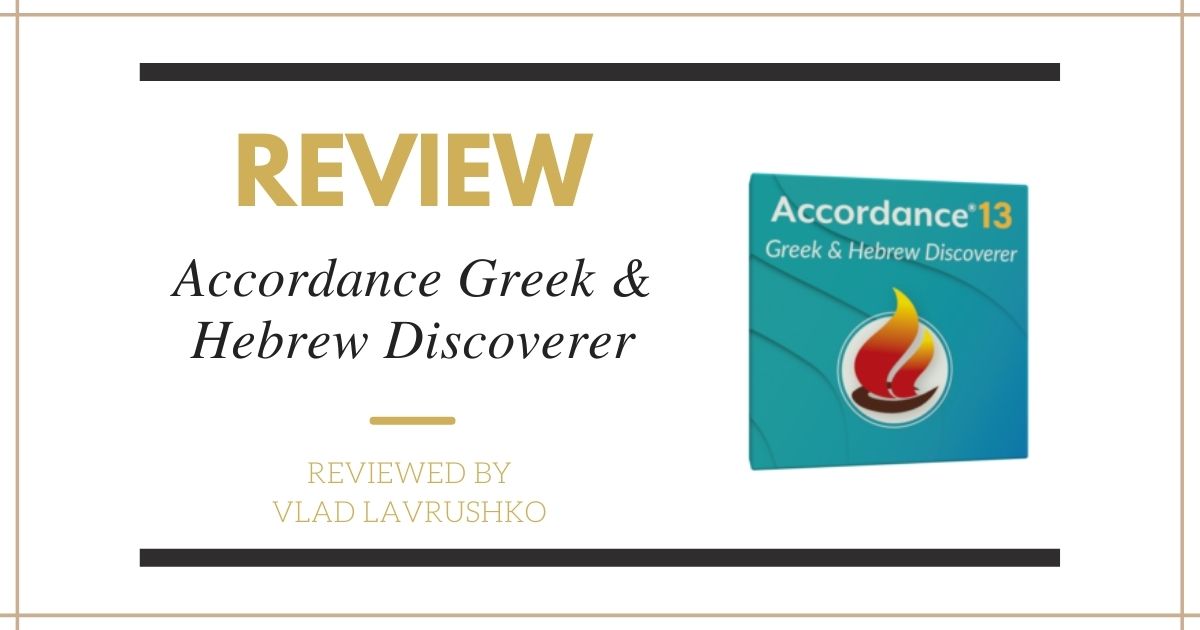Review by Volodymyr Lavrushko

One of my favorite aspects of my seminary years at Tyndale Theological Seminary was the morning Bible reading in the original languages. Students and the New Testament professor usually met in the dining hall to have breakfast (or cup of tea) and read the Bible together. Initially we only read the New Testament in Greek. Later on, the Hebrew Old Testament was introduced to our morning routine. As we read the Hebrew text sometimes, we compared it with the Septuagint translation. This practice was a wonderful way to deepen one’s knowledge of God’s Word in the original languages and at times it might also spark an interest in further research.
Accordance 13 Greek & Hebrew Discoverer Collection is a great companion for such reading of the biblical text as it has been designed for “those who are going deeper in their studies of either Hebrew or Greek.”[1]
On the screen shot below you can see the Hebrew text of Genesis 4 and, in the parallel column with corresponding text, of the Septuagint. These are the texts of the standard editions: Biblia Hebraica Stuttgartensia with ETCBC Morphology and Greek Septuagint (Rahlfs) revised and tagged. As you move the cursor over either the Hebrew or Greek text, the corresponding words are highlighted in the parallel column. Accordance software usually has an instant details window with the parsings and meanings of the words. I prefer not using this function. Instead, if some help is needed, I prefer to use the right click and choose the “look up” option to check the meaning in one’s favorite lexicon. On the screen shot below I am using The Concise Dictionary of Classical Hebrew edited by David J. A. Clines.

You might also like the interlinear option for the comparison of Masoretic and Septuagint texts:

There is another feature of Accordance in the left column in which you can organize your library as you like by dragging books into a preferred folder or category (in this case – grammars) and organizing books into subdivisions inside the selected folder. For example, I organized my grammars into three categories: Hebrew, Septuagint, and New Testament Greek grammars. As you can see in terms of grammars, Accordance 13 Greek & Hebrew Discoverer Collection is especially helpful for studying New Testament and Septuagint Greek, and not as much for Hebrew.
Let’s come back to the feature we pointed out earlier – the corresponding highlighting of the Hebrew and Greek texts in the parallel columns or in the interlinear. This is a very useful feature, however it needs to be used with care since it won’t work properly at points when the Masoretic text differs from the Septuagint, such as in Genesis 5. On the screen shot below the Hebrew word for conjunction “and” (וּ) corresponds to Greek word that means “two hundred” (διακόσια).

On the screen shot above, in the left column again one can see the list of Greek Lexicons categorized as follows: Septuagint, New Testament and Theological lexicons or dictionaries. The Accordance 13 Greek & Hebrew Discoverer Collection includes the following lexicons:
- Complete Word Study Dictionary: New Testament
- Strong’s Greek Dictionary
- Mounce Concise Greek-English Dictionary of the New Testament
- Trench’s Synonyms of the New Testament
- Thayer’s Greek-English Lexicon of the New Testament
- LEH Septuagint Lexicon (3rd Edition)
- Louw & Nida Semantic Domain Lexicon
- Greek-English Dictionary of the NT, Concise, by Barclay Newman (2010 Revision)
- Spicq Theological Lexicon of the NT
- Theological Dictionary of the New Testament (Little Kittel)
It is a good selection for intermediate studies; however, one would need to consult the standard Greek Lexicon – BDAG – for any academic articles and papers. Unfortunately, BDAG is not included in this collection. Among available lexicons and dictionaries in this collection I most often use: LEH Septuagint Lexicon (3rd Edition); Louw & Nida Semantic Domain Lexicon; Spicq Theological Lexicon of the NT; and Theological Dictionary of the New Testament (Little Kittel).
Accordance 13 is a powerful tool for studying the Bible in the original languages. It has numerous features. I really enjoyed exploring some of them with the built-in tutorials. On the screen shot below you can check their “Atlas” feature, which is creative and fun. If you own Accordance, I would like to encourage you to explore the features you are most interested in.

Lastly, I would like to say a couple of words regarding the Workspace feature. There are a few pre-set Workspaces available in the program. You check them out by following this path (File –> Open Workspaces).
Here is a screen shot of the NT Study Workspace. Double click on either the English or Greek word which would provide you with instant access to both “word usage” and a “lexicon lookup” features. These functions include basically everything you need for solid word study. The “word usage” feature is a concordance which has the ability to use any of the translations available in your copy of Accordance. The “lexicon lookup” on the other hand enables you to check the meaning of a Greek word, in this case in any lexicon, dictionary, or other tool in your library.

In a nutshell, I have enjoyed exploring Accordance and would recommend this program to anyone who would want engage in serious Bible study.
Disclaimer: My copy of Accordance includes more books than are available in Greek & Hebrew Discoverer Collection (Accordance 13), so the screenshots in this review might include the pictures of books not included into Greek & Hebrew Discoverer Collection (Accordance 13). Therefore, please check the official website for more information regarding exact resources included in the package.
[1] https://accordancebible.com/product/greek-hebrew-discoverer-collection-accordance-13/, accessed on January 24, 2022.

